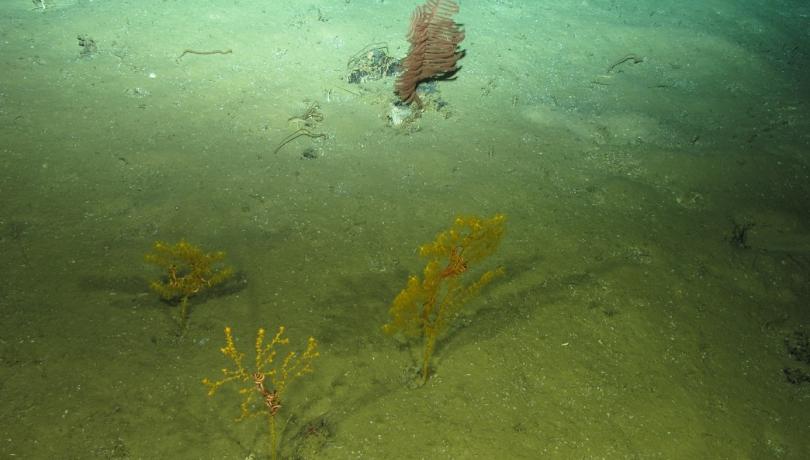Researchers from the IEO and the ICM have contributed to the first unified vision of the world ocean biodiversity.

Researchers from the Instituto Oceanográfico Español (IEO-CSIC) and the Institut de Ciències del Mar (ICM-CSIC) have contributed to the first unified vision of the world ocean biodiversity, based on analysis of DNA sequences from the surface to deep-ocean sediments. These findings unveil the rich and unknown life in the abyssal realm, the last terra incognita of the Earth surface.
The deep-ocean floor is the least explored ecosystem on the planet, despite covering more than 60% of the Earth surface. Largely unknown life in abyssal sediments, from benthic animals to microbes, helps to recycle and/or sequester the sinking (in)organic matter originating from pelagic communities that are numerically dominated by microscopic plankton.
Benthic ecosystems thus underpin two major ecosystem services of planetary importance: the healthy functioning of ocean food-webs and the burial of carbon on geological timescales, both of which are critical regulators of the Earth climate.
The work, published in the journal Science Advances and signed by an international team from eight countries belonging to different research centres, includes the results of a massive sequencing of eukaryotic DNA contained in deep-sea sediments from all major oceanic basins, and compares these new data to existing global-scale plankton datasets from the sunlit and dark water column, obtained by the Tara Oceans and Malaspina circumglobal expeditions.
This provides the first unified vision of the full ocean eukaryotic biodiversity, from the surface to the deep-ocean sediment, allowing marine ecological questions to be addressed for the first time at a global scale and across the three-dimensional space of the ocean, representing a major step towards “One Ocean ecology”.
“With nearly 1700 samples and two billion DNA sequences from the surface to the deep-ocean floor worldwide, high-throughput environmental genomics vastly expands our capacity to study and understand deep-sea biodiversity, its connection to the water masses above and to the global carbon cycle”, says Tristan Cordier, Researcher at NORCE and Bjerknes Centre for Climate Research, Norway, and lead author of the study.
What lives in this dark and hostile environment?
By comparing sediment DNA sequences with the ones from pelagic realms, it was possible to distinguish indigenous benthic organisms from sinking plankton that had reached the seafloor from the overlying water column. Results indicate that this benthic biodiversity could be three times larger than in the water masses above; and this diversity is composed of very different taxonomic groups that are mostly unknown.
“We compared our deep-sea benthic DNA sequences to all references sequences available for known eukaryotes. Our data indicates that nearly two third of this benthic diversity cannot be assigned to any known group, revealing a major gap in our knowledge of marine biodiversity”, says Jan Pawlowski, Professor at the Department of Genetics and Evolution of the University of Geneva and at the Institute of Oceanology of the Polish Academy of Sciences in Sopot.
What can plankton DNA in deep-sea sediments tell us?
Analysis of the abundance and composition of plankton DNA in deep-sea sediments confirmed that polar regions are hotspots of carbon sequestration. Moreover, the composition of the plankton DNA in sediments predicts the variation of the strength of the biological pump, an ecosystem process that transfer atmospheric carbon dioxide into the deep ocean, hence regulating the global climate.
How will the deep-sea be impacted by global changes?
This genomic dataset represents the first consistent snapshot of whole eukaryotic diversity in the modern ocean. It provides a unique opportunity to reconstruct ancient oceans from the DNA contained in the cumulative sediment record, to assess how climate has impacted plankton and benthic communities in the past.
“Our data will serve as a basis to reconstruct the past functioning of the biological pump from ancient sedimentary DNA archives. It would then inform on its future strength in a warmer ocean, which is key for modelling the future carbon cycle under climate change”, explains Tristan Cordier.
"While studies in surface waters had already demonstrated the prevalence of new diversity, this novelty is much more exaggerated on the ocean floor. These as yet unknown organisms probably play a key role in ecological processes and biogeochemical cycles. Thus, a better understanding of this high diversity is crucial if we are to protect these vast and still relatively pristine ecosystems from the impacts of possible future human incursions and climate change", concludes Ramon Massana, ICM-CSIC researcher and co-author of the paper.
The importance of international collaboration
This work is the result of a huge collective effort, thanks to the data collected in 15 international deep-sea expeditions. One of these campaigns, in Mediterranean and North Atlantic waters, was the MEDWAVES campaign, led by IEO researcher Covadonga Orejas Saco del Valle: "Research like this is a clear example that international collaboration is essential in research to address global issues, such as the study of oceanic biodiversity, which also require global strategies for its proper management and conservation," points out the scientist.